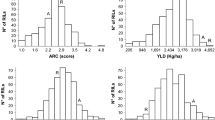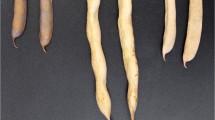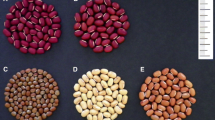Abstract
Key message
The QTLs analyses here reported demonstrate the significant role of both individual additive and epistatic effects in the genetic control of seed quality traits in the Andean common bean.
Abstract
Common bean shows considerable variability in seed size and coat color, which are important agronomic traits determining farmer and consumer acceptability. Therefore, strategies must be devised to improve the genetic base of cultivated germplasm with new alleles that would contribute positively to breeding programs. For that purpose, a population of 185 recombinant inbred lines derived from an Andean intra-gene pool cross, involving an adapted common bean (PMB0225 parent) and an exotic nuña bean (PHA1037 parent), was evaluated under six different—short and long-day—environmental conditions for seed dimension, weight, color, and brightness traits, as well as the number of seed per pod. A multi-environment Quantitative Trait Loci (QTL) analysis was carried out and 59 QTLs were mapped on all linkage groups, 18 of which had only individual additive effects, while 27 showed only epistatic effects and 14 had both individual additive and epistatic effects. Multivariate models that included significant QTL explained from 8 to 68 % and 2 to 15 % of the additive and epistatic effects, respectively. Most of these QTLs were consistent over environment, though interactions between QTLs and environments were also detected. Despite this, QTLs with differential effect on long-day and short-day environments were not found. QTLs identified were positioned in cluster, suggesting that either pleiotropic QTLs control several traits or tightly linked QTLs for different traits map together in the same genomic regions. Overall, our results show that digenic epistatic interactions clearly play an important role in the genetic control of seed quality traits in the Andean common bean.

Similar content being viewed by others
References
Acosta-Gallegos JA, Kelly JD, Gepts P (2007) Prebreeding in common bean and use of genetic diversity from wild germplasm. Crop Sci 47(S3):S44–S59
Adams MW (1967) Basis of yield compensation in crop plants with special reference to the field bean, Phaseolus vulgaris. Crop Sci 7:505–510
Al-Mukhtar FA, Coyne DP (1981) Inheritance and association of flower, ovule, seed, pod, and maturity characters in dry edible beans (Phaseolus vulgaris L.). J Am Soc Hortic Sci 106:713–719
Bassett MJ (2007) Genetics of seed coat color and pattern in common bean. Plant Breed Rev 28:239–315
Bassett MJ, McClean PE (2000) A brief review of the genetics of partly colored seed coats in common bean. Annu Rep Bean Improv Coop 43:99–101
Beattie AD, Larsen J, Michaels TE, Pauls KP (2003) Mapping quantitative trait loci for a common bean (Phaseolus vulgaris L.) ideotype. Genome 46:411–422
Beninger CW, Hosfield GL (1999) Flavonoid composition of three genotypes of dry bean (Phaseolus vulgaris) differing in seed coat color. J Am Soc Hortic Sci 124:514–518
Beninger CW, Hosfield GL (2003) Antioxidant activity of extracts, condensed tannin fractions, and pure flavonoids from Phaseolus vulgaris L. seed coat color genotypes. J Agric Food Chem 51:7879–7883
Beninger CW, Hosfield GL, Basset MJ, Owens S (2000) Chemical and morphological expression of the B and Asp seedcoat genes in Phaseolus vulgaris. J Am Soc Hortic Sci 125:52–58
Blair MW, Iriarte G, Beebe S (2006) QTL analysis of yield traits in an advanced backcross population derived from a cultivated Andean wild common bean (Phaseolus vulgaris L.) cross. Theor Appl Genet 112:1149–1163
Broughton WJ, Hernández G, Blair M, Beebe S, Gepts P, Vanderleyden J (2003) Beans (Phaseolus spp.)—model food legumes. Plant Soil 252:55–128
Caldas GV, Blair MW (2009) Inheritance of seed condensed tannins and their relationship with seed-coat color and pattern genes in common bean (Phaseolus vulgaris L.). Theor Appl Genet 119:131–142
Chacón MI, Pickersgill SB, Debouck DG (2005) Domestication patterns in common bean (Phaseolus vulgaris L.) and the origin of the Mesoamerican and Andean cultivated races. Theor Appl Genet 110:432–444
Conti L (1982) Bean germplasm evaluation from the collection at Minoprio (Como, Italy) in view of a breeding program for the improvement of the protein content of the seed. Genetica Agraria 35:375–392
Conti L (1985) Conclusive results of a selection program for obtaining a dwarf bean (P. vulgaris) resistant to some viruses and characterized by agronomical qualities. Genetica Agraria 39:51–63
Emerson PA (1909) Factors for mottling in beans. Am Breed Assoc 5:368–376
Erdmann PM, Lee RK, Bassett MJ, McClean PE (2002) A molecular marker tightly linked to P, a gene required for flower and seedcoat color in common bean (Phaseolus vulgaris L.), contains the Ty3- gypsy retrotransposon Tpv3 g. Genome 45:728–736
Escribano MR, Santalla M, de Ron AM (1997) Genetic diversity in pod and seed quality traits of common bean populations from northwestern Spain. Euphytica 93:71–81
Gepts P (1998) Origin and evolution of common bean: past events and recent trends. HortScience 33:1124–1130
Gepts P, Osborn T, Rashka K, Bliss F (1986) Phaseolin-protein variability in wild forms and landraces of the common bean (Phaseolus vulgaris L.): evidence for multiple centers of domestication. Econ Bot 40:451–468
Guzman-Maldonado SH, Martínez O, Acosta-Gallegos JA, Guevara-Lara F, Paredes-López O (2003) Putative quantitative trait loci for physical and chemical components of common bean. Crop Sci 43:1029–1035
Holland JB (2001) Epistasis and plant breeding. Plant Breed Rev 21:27–82
Holland JB (2006) Estimating genotypic correlations and their standard errors using multivariate restricted maximum likelihood estimation in SAS Proc MIXED. Crop Sci 46:642–654
Holland JB, Nyquist WE, Cervantes-Martínez CT (2003) Estimating and interpreting heritability for plant breeding: an update. Plant Breed Rev 22:9–112
Johnson WC, Gepts P (2002) The role of epistasis in controlling seed yield and other agronomic traits in an Andean × Mesoamerican cross of common bean (Phaseolus vulgaris L.). Euphytica 125:69–79
Koinange EMK, Singh SP, Gepts P (1996) Genetic control of the domestication syndrome in common bean. Crop Sci 36:1037–1045
Kosambi DD (1944) The estimation of map distances from recombination values. Ann Eugen 12:172–175
Lamprecht H (1940) Zur Genetik von Phaseolus vulgaris XVII–XVIII. Zwei neue Gene fur Abzeichen auf der Testa “Punc” and “Mip” sowie die Virkung von “V” und “Inh”. Hereditas 26:292–304
Lark KG, Chase K, Adler F, Mansur LM, Orf JH (1995) Interactions between quantitative trait loci in soybean in which trait variation at one locus is conditional upon a specific allele at another. Proc Natl Acad Sci USA 92:4656–4660
Littell RC, Milliken GA, Stroup WW, Wolfinger RD (1996) SAS system for mixed models. SAS Institute, Cary
Mace ES, Jordan DR (2011) Integrating sorghum whole genome sequence information with a compendium of sorghum QTL studies reveals uneven distribution of QTL and of gene- rich regions with significant implications for crop improvement. Theor Appl Genet 123:169–191
McClean PE, Lee RK, Otto C, Gepts P, Bassett MJ (2002) Molecular and phenotypic mapping of genes controlling seed coat pattern and color in common bean (Phaseolus vulgaris L.). J Hered 93:148–152
Miklas PN, Porch T (2010) Guidelines for common bean QTL nomenclature. Annu Rep Bean Improv Coop 53:202–204
Miklas PN, Delorme R, Stone V, Daly MJ, Stavely JR, Steadman JR, Bassett MJ, Beaver JS (2000) Bacterial, fungal, and viral disease resistance loci mapped in a recombinant inbred common bean population (‘Dorado’/XAN 176). J Am Soc Hortic Sci 125:476–481
Moreto AL, Patto Ramalho MA, Bruzi AT (2012) Epistasis in an Andean × Mesoamerican cross of common bean. Euphytica 186:755–760
Park SO, Coyne DP, Jung G, Skroch PW, Arnaud-Santana E, Steadman JR, Ariyarathne HM, Nienhuis J (2000) Mapping of QTL for seed size and shape traits in common bean. J Am Soc Hortic Sci 125:466–475
Pedrosa-Harand A, Porch T, Gepts T (2008) Standard nomenclature for common bean chromosomes and linkage groups. Annu Rep Bean Improv Coop 51:106–107
Pérez-Vega E, Pañeda A, Rodríguez-Suárez C, Campa A, Giraldez R, Ferreira JJ (2010) Mapping of QTLs for morpho-agronomic and seed quality traits in a RIL population of common bean (Phaseolus vulgaris L.). Theor Appl Genet 120:1367–1380
Prakken R (1970) Inheritance of colours in Phaseolus vulgaris L. II. A critical review. Mededelingen Landbouwhogeschool Wageningen 70:1–38
Prakken R (1972) Inheritance of colours in Phaseolus vulgaris L. III. On genes for red seedcoat color and a general synthesis. Mededelingen Landbouwhogeschool Wageningen 72:1–82
Santalla M, Rodiño AP, González AM, Monteagudo AB, De Ron AM (2005) Improvement of large-seeded common bean cultivars under sustainable cropping system in Spain. Euphytica 142:85–95
Sax K (1923) The association of size differences with seed coat pattern and pigmentation in Phaseolus vulgaris. Genetics 8:552–560
Singh SP (1991) Bean genetics. In: Van Schoonhoven A, Voysest O (eds) Common beans: research for crop improvement. CAB Int, Wallingford and CIAT, Cali, pp 199–286
Singh SP (2001) Broadening the genetic base of common bean cultivars: a review. Crop Sci 41:1659–1675
Takeoka GR, Dao LT, Full GH, Wong RY, Harden LA, Edwards RH, de J Berrios J (1997) Characterization of black bean (Phaseolus vulgaris L.) anthocyanins. J Agric Food Chem 45:3395–3400
Tanksley SD, McCouch SR (1997) Seed banks and molecular maps: unlocking genetic potential from the wild. Science 277:1063–1066
Tar’an B, Michaels TE, Pauls KP (2002) Genetic mapping of agronomic traits in common bean. Crop Sci 42:544–556
Templeton AR (1981) Mechanisms of speciation—a population genetic approach. Annu Rev Ecol Syst 12:23–48
Tsai SM, Nodari RO, Moon DH, Camargo LEA, Vencovsky R, Geps P (1998) QTL mapping for nodule number and common bacterial blight in Phaseolus vulgaris L. Plant Soil 204:135–145
Vallejos CE, Chase CD (1991) Linkage between isozyme markers and a locus affecting seed size in Phaseolus vulgaris L. Theor Appl Genet 81:413–419
Vallejos CE, Sakiyama NS, Chase CD (1992) A molecular-marker-based linkage map of Phaseolus vulgaris L. Genetics 131:733–740
van Ooijen JH (2006) JoinMap®4, software for the calculation of genetic linkage maps in experimental populations. Kyazma BV, Wageningen
Varshney RK, Song C, Saxena RK, Azam S, Yu S, Sharpe AG, Cannon S, Baek J, Rosen BD, Tar’an B, Millan T, Zhang X, Ramsay LD, Iwata A, Wang Y, Nelson W, Farmer AD, Gaur PM et al (2013) Draft genome sequence of chickpea (Cicer arietinum) provides a resource for trait improvement. Nat Biotechnol 31:240–246
Voorrips RE (2002) MapChart: software for the graphical presentation of linkage maps and QTLs. J Hered 93:77–78
Voysest O (1983) Variedades de fríjol en América Latina y su origen. Centro Internacional de Agricultura Tropical, Cali 87p
Wang CS, Rutledge JJ, Gianola D (1994) Bayesian analysis of mixed linear models via Gibbs sampling with an application to litter size in Iberian pigs. Genet Sel Evol 26:91–115
Welsh W, Bushuk W, Roca W, Singh SP (1995) Characterization of agronomic traits and markers of recombinant inbred lines from intra- and interracial populations of Phaseolus vulgaris L. Theor Appl Genet 91:169–177
Xiao J, Li J, Yuan L, Tanksley SD (1996) Identification of QTLs affecting traits of agronomic importance in a recombinant inbred population derived from a subspecific rice cross. Theor Appl Genet 92:230–244
Yang J, Hu CC, Hu H, Yu RD, Xia Z, Ye XZ, Zhu J (2008) QTLNetwork: mapping and visualizing genetic architecture of complex traits in experimental populations. Bioinformatics 24:721–723
Yuste-Lisbona FJ, Santalla M, Capel C, García-Alcázar M, De La Fuente M, Capel J, De Ron AM, Lozano R (2012) Marker-based linkage map of Andean common bean (Phaseolus vulgaris L.) and mapping of QTLs underlying popping ability traits. BMC Plant Biol 12:136
Zimmerer C (1986) “La Ñuña”. En V Congreso Internacional de Sistemas Agropecuarios Andinos, CODE PUNO, INIPA-CIPA XV. Puno
Acknowledgments
The research has been funded by grant AGL2011-25562 from the Ministerio de Economía y Competitividad (Spain). We also thank Campus de Excelencia Internacional Agroalimentario (CeiA3) for supporting in part this work.
Conflict of interest
The authors declare that they have no conflict of interest.
Ethical standards
Experiments conducted for this study comply with the current laws of Spain.
Author information
Authors and Affiliations
Corresponding author
Additional information
Communicated by B. Diers.
F. J. Yuste-Lisbona and A. M. González should be regarded as joint first authors.
Rights and permissions
About this article
Cite this article
Yuste-Lisbona, F.J., González, A.M., Capel, C. et al. Genetic analysis of single-locus and epistatic QTLs for seed traits in an adapted × nuña RIL population of common bean (Phaseolus vulgaris L.). Theor Appl Genet 127, 897–912 (2014). https://doi.org/10.1007/s00122-014-2265-3
Received:
Accepted:
Published:
Issue Date:
DOI: https://doi.org/10.1007/s00122-014-2265-3




